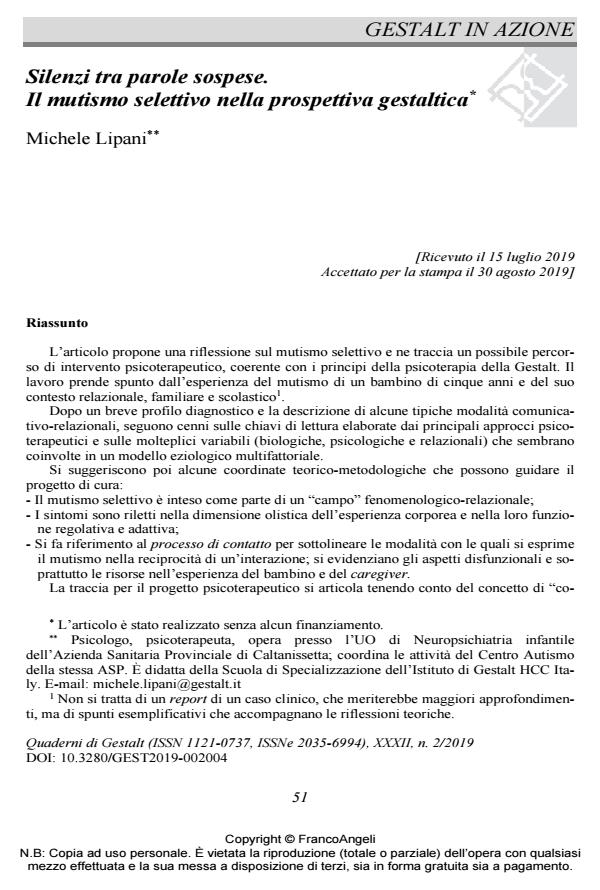Silence Between Suspended Words. Selective Mutism in the Gestalt Perspective
Journal title QUADERNI DI GESTALT
Author/s Michele Lipani
Publishing Year 2020 Issue 2019/2
Language Italian Pages 27 P. 51-77 File size 263 KB
DOI 10.3280/GEST2019-002004
DOI is like a bar code for intellectual property: to have more infomation
click here
Below, you can see the article first page
If you want to buy this article in PDF format, you can do it, following the instructions to buy download credits

FrancoAngeli is member of Publishers International Linking Association, Inc (PILA), a not-for-profit association which run the CrossRef service enabling links to and from online scholarly content.
This article proposes a reflection on the selective mutism and traces a possible path of psy-chotherapeutic intervention, consistent with the principles of Gestalt psychotherapy. The work takes its cue from the experience of the muteness of a five-year-old child and his relational, family and school context. After a brief diagnostic profile and the description of some typical communicative-relational modalities, a few hints on the toughts elaborated by the main psychotherapeutic approaches follow, and on the multiple variables (biological, psychological and relational) that seem to be involved in a multifactorial etiological model. Then some theoretical-methodological frames are suggested, aimed to guide the therapeutic project: - Selective mutism is understood as part of a phenomenological-relational "field"; - The symptoms are seen in the holistic dimension of the bodily experience and in their regula-tory and adaptive function; - Finally, reference is made to the contact process to underline the ways in which the mutism is expressed in the reciprocity of an interaction; we highlight the dysfunctional aspects and especially the resources in the experience of the child and the caregiver. The trace for the psychotherapeutic project is divided into three parts: - The intervention with family members, with a starting point for a phenomenological observa-tion of the reciprocity between child and parent (we refer to the model of "dance steps", developed by the Institute of Gestalt HCC Italy) and a nod to some themes present in the family with selective mutism; - The second area of the intervention proposes some indications on the therapeutic relationship with the child, suggesting a particular attention to the intersubjective dimension (which en-hances the therapist’s resonance skills through an aesthetic relational knowledge) and to the child’s ability to attune and synchronize; - Finally, some topics that can accompany the experience of the child with selective mutism at school are presented, and some guide lines for a collaboration between psychotherapist and teachers are suggested.
Keywords: Selective mutism, freezing, aesthetic relational knowledge, phenomenological ob-servation of the relationship.
Michele Lipani, Silenzi tra parole sospese. Il mutismo selettivo nella prospettiva gestaltica in "QUADERNI DI GESTALT" 2/2019, pp 51-77, DOI: 10.3280/GEST2019-002004